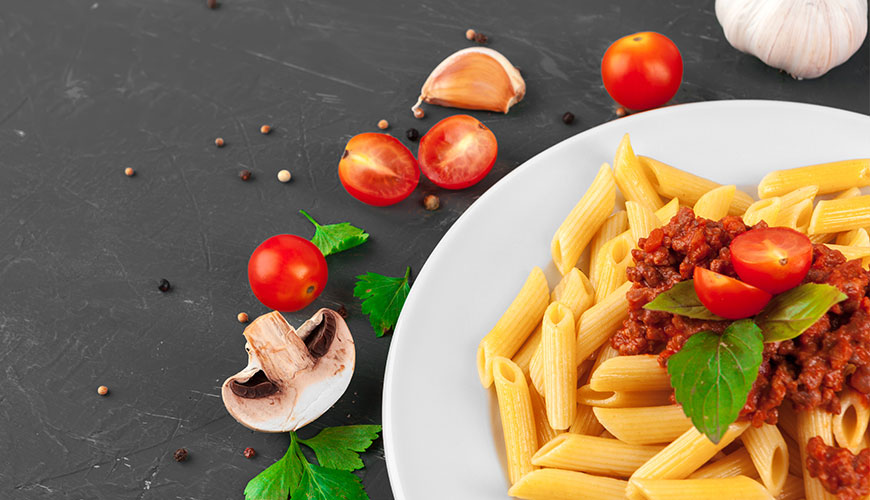Pasta is quite rich in Vitamin B6, Thiamine, folic acid, Vitamin E, magnesium, zinc, copper, pulp and bioactive components. We can say that the common opinion of all nutrition and diet experts is this: "Pasta does not cause wieght gain!". In a study conducted in Europe on 20.000 volunteers, it is found that people who eat pasta more often in their diet are thinner, they have thinner waists, more ideal waist-hip ratio and have lower chances of obesity. In another study conducted in 2015, it is found that the children who eat pasta have better nutrition than those who don't, and that they have more pulps, Vitamin D, calcium, potassium, magnesium, iron, folic acid and Vitamin E.
Pasta has lower glycemic index values. As a result of many studies and in the International Carbohydrate Quality Consortium of 2015, it is agreed that foods with lower glycemic indexes decrease the risks of diabetes, metabolic syndrome, cardiac and vascular diseases, insuline resistance and stroke and additionally, that pasta is a food with lower glycemic index values.
Pasta is rich in pulp. It is found out that people who regularly eat foods rich in pulp such as pasta; have lower blood fat (triglyceride and bad cholesterole) and have lower risks of cancer and hypertension.
Pasta is quite rich in Vitamin B1 With this feature, it enchances the immune system and neural system, it decreases the risks of neurodegenerative diseases such as Alzheimer's disease.
Pasta, especially with its structure rich in pulp, expedites the bowel movements and therefore, expedites the metabolism. Therefore, pasta is a food which makes the weight-loss period easier and ensures fulness with its lower glycemic index values.
Since it is a source of resistant starch, is a good probiotic. When pasta is cooked and rested and consumed while warm, its resistant starch contents appear. Since resistant starch is resistant against digestive enzymes, it can travel to the bowel without any structural disturbances and creates a food source for the good bacteria in our bowel which creates our microbiota and as a result, fatty acid with shorter chains appear and bowel pH is decreased. With this feature, fat usage ratio increases and weight loss becomes easier. Therefore, pasta, while not causing weight-gain, instead supports the weight-loss process.
Pasta is a quality source of carbohydrates. Main fuel of the brain is glucose, in other words, blood sugar. Since pasta ensures the protection of the levels of blood sugar, supports the learning process. Everyone should include pasta in their diets.
Carbon footprint of a food, means the damage it caused to the environment and the nature from the production phase until it is on our tables. As carbon footprint decreases, the food becomes good for the nature.
Pasta, in addition to being a plant based food, is also a green foot with lower carbon footprints. Pasta has lower carbon footprints than most of the foods we know.
According to the Turkey Dietary Guide published in 2015, you need to consume 3 to 7 portions of grains each day to meet your carbohydrate requirements. You can meet this requirement with at least 2 thin slices of bread and 150 g cooked pasta or with at most 6 thin slices of bread and 300g cooked pasta.
Pasta doe not cause weight gain, instead it is a healthy food. Don't forget, every food can cause weight gain without portion control. We wish you a pasta-ful day!
REFERENCES
- Björck, I, et al. The Glycaemic Index: Importance of Dietary Fibre and Other Food Properties, Proceedings of the Nutrition Society (2003), 62, 201-206.
- Huang, M. Et al. Pasta Meal Intake In Relation to Risks of Type 2 Diabetes and Atherosclerotic Cardiovascular Disease in Postmenopausal Women: Findings From the Women’s Health Initiative, BMJ Nutrition, Prevention & Health (2021), 4, 195-205.
- Chiavaroli, L. Et al. Effect of low glycaemic index or load dietary patterns on glycaemic control and cardiometabolic risk factors in diabetes: systematic review and meta-analysis of randomised controlled trials, BMJ (2021), 374, 1651.
- Cleveland, L.E., Dietary Intake of Whole Grains, Journal of the American College of Nutrition (2014), 19(3), 331-338.
- Papanikolaou, Y., Pasta Concumption Is Lınked to Greater Nutrient Intakes and Improved Diet Quality in American Children and Adults, and Beneficial Weight Related Outcomes Only in Adult Females, Frontiers in Nutrition (2020), 7, 112.
- A Systematic Review On The Relations Between Pasta Consumption and Cardio-metabolic Risk Factors, Nutrition, Metabolism and Cardiovascular Diseases (2017), doi: 10.1016/j.numecd.2017.07.005.
- Krishnan, M. Health Based Pasta: Redefining the Concept of the Next Generation Convenience Food (2012), 52:1, 9-20.
- Augustin, L.S.A. et al, Dietary Fibre Consensus from the International Carbohydrate Quality Consortium (ICQC), Nutrients (2020), 12, 2553.
- Webb, D. Pasta’s History and Role in Healthful Diets, Food and Nutrition (2019), 54(5), 212-220.
- Turkey Dietary Guide, T.C. The Ministry of Health, General Directorate of Public Health, 2019, Ankara.
